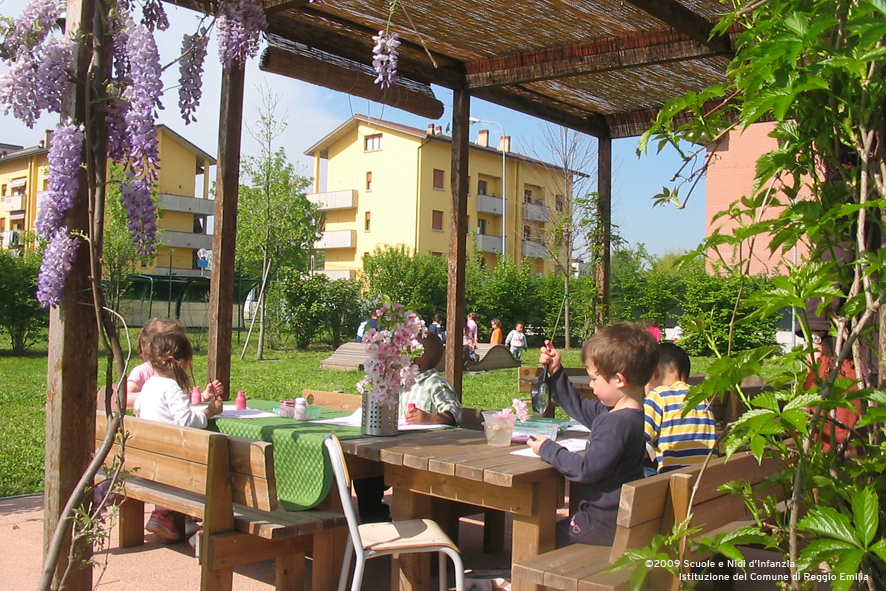We are fortunate to have befriended Harold Gothson from Stockholm, Sweden. Harold visited St. Louis for a conference in our early years working with the St. Louis Reggio Collaborative, we have been with him in Reggio Emilia several times and he has worked with us in Vermont. A few summers ago, we visited him in Sweden and also Gunilla Dahlberg. The Swedes have been good friends of the educators in Reggio Emilia since the 80’s and founded the Reggio Emilia Institute in Stockholm in 1992. Harold gave us a film produced by Carlo Barsotti entitled, “The Man from Reggio Emilia.” I just watched this charming film and feel as if I have been following Loris Malaguzzi around town and on his travels. It turns out that this film was made right around the time that we lived in Reggio Emilia in 1991-92. We know many of the people in the film who have become our friends. And, they look the way we all did roughly 25 years ago. I feel I have been in a time warp.
I was so fortunate to live in Reggio Emilia when Loris Malaguzzi was still very involved with the schools. He was very much a presence, especially at Diana School, and I was lucky to attend many meetings small and large with him and the teachers. He died January 30th, 1994, just as the film was being completed.
The film shows many endearing and also tough sides of this brilliant man, the founder of the Reggio Approach. He says of himself, “I have a huge ego and I don’t like to loose a fight! I like to win!” Carlina Rinaldi, President of the Reggio Children foundation, speaks of the challenges and rewards of working with him. Vea Vecchi, atelierista for many years at the Diana School and author of Art and Creativity in Reggio Emilia, says that she enjoys fighting with him “marvelously well!” Their arguments are not personal, rather they entered into deep dialogue about ideas.
Watching this film and listening to Malaguzzi speak reminded me of his list of beliefs about creativity that was part of an interview with Lella Gandini in 1990 on the meaning of creativity. We printed them in the epilogue in the second edition of In the Spirit of the Studio: Learning from the Atelier of Reggio Emilia. Here are his thoughts…good ones to ponder as we all have leisure time to relax, let creativity into our own lives a little more, and nurture and renew ourselves for creative work with children when fall returns.
As we have chosen to work with children we can say that they are the best evaluators and the most sensitive judges of the values of creativity. This comes about because they have the privilege of not being excessively attached to their own ideas, which they construct and reinvent continuously. They are apt to explore, make discoveries, change their points of view, and fall in love with forms and meanings that transform themselves.
Therefore, we do not consider creativity sacred, we do not consider it as extraordinary but rather as likely to emerge from daily experience. This view is now shared by many. We can sum up our beliefs as follows:
1. Creativity should not be considered a separate mental faculty but a characteristic of our way of thinking, knowing, and making choices.
2. Creativity seems to emerge from multiple experiences, coupled with a well-supported development of personal resources including a sense of freedom to venture beyond the known.
3. Creativity seems to express itself through cognitive, affective, and imaginative processes. These come together and support the skills for predicting and arriving at unexpected solutions.
4. The most favorable situation for creativity seems to be interpersonal exchange, with negotiation of conflict and comparison of ideas and actions being decisive elements.
5. Creativity seems to find its power when adults are less tied to prescriptive methods, but instead become observers and interpreters of problematic situations.
6. Creativity seems to be favored or disfavored according to the expectation of the teachers, schools, families, and communities as well as society at large according to the ways children perceive those expectations.
7. Creativity becomes more visible when adults try to be more attentive to the cognitive processes of children than to the results they achieve in various fields of doing and understanding.
8. The more teachers are convinced that intellectual and expressive activities have both multiplying and unifying possibilities, the more creativity favors friendly exchanges with imagination and fantasy.
9. Creativity requires that the school of knowing finds connections with the school of expressing, opening doors (this is our slogan) to the hundred languages of children.
Often when people come to us and observe our children, they ask us which magic spell we have used. We answer that their surprise equals our surprise. Creativity? It is always difficult to notice when it is dressed in everyday clothing and has the ability to appear and disappear suddenly. Our task regarding creativity is to help children to climb their own mountains. No one can do more.
From Malaguzzi, L. (1998). History, ideas, and basic philosophy. In C. P. Edwards, L. Gandini,, & G. Forman (Eds). The hundred languages of children: The Reggio Emilia Approach-Advanced reflections (2nded.;pp.49-97. Westport, CT: Ablex.



